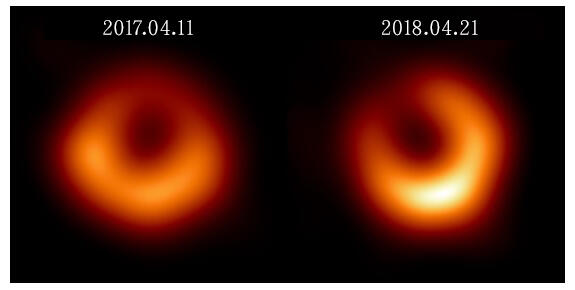The Event Horizon Telescope (EHT) Collaboration reported new images of M87*, a giant black hole located 55 million light years from Earth. The new photographs were taken in 2018, approximately one year after the first photograph of the black hole was reported in 2017. The images show that the brightest spot on the ring around the black hole had shifted in the five o'clock direction. This means it is possible that the gas flow falling into the black hole might be altering every several days.

Credit: EHT Collaboration
Assistant Professor Shoko Koyama (Graduate School of Science and Technology, Niigata University) explained, "The mass of a black hole alone determines the diameter of its ring, as predicted by the general theory of relativity. The Greenland telescope was used for the first time in the 2018 observations, enhancing the image resolution. The ring diameter was found to be the same as in 2017. This means the accuracy of the general relativity theory has been affirmed further."
Yutaro Kofuji (PhD student at the University of Tokyo) added, "According to our simulation, the alteration in the brightness of the ring suggests the movement of some substance in the turbulence close to the black hole. As we continue observing it further, we might reveal the accumulation of matter into black holes."
Professor Masanori Nakamura (National Institute of Technology, Hachinohe College) said, "A large number of Japanese scientists joined at the early stage of the planning of the observation of the black hole M87* and has been contributing to the observation efforts. This time, they were involved in the construction, development, and operation of the Greenland telescope and made a huge contribution."
Professor Mareki Honma (Manager at the Mizusawa VLBI Observatory, National Astronomical Observatory of Japan) said, "The observation based on millimeter waves has revealed that the black hole is rotating. Korea is planning to join in the project with its new telescope in 2024 or thereafter. The next-generation EHT, a concept to add new stations, is currently being assessed. Our understanding of black holes will be taking a great leap forward if we are able to use a variety of wavelengths for video recording in the future."
Journal Information
Publication: Astronomy and Astrophysics
Title: The persistent shadow of the supermassive black hole of M 87
DOI: 10.1051/0004-6361/202347932
This article has been translated by JST with permission from The Science News Ltd. (https://sci-news.co.jp/). Unauthorized reproduction of the article and photographs is prohibited.




